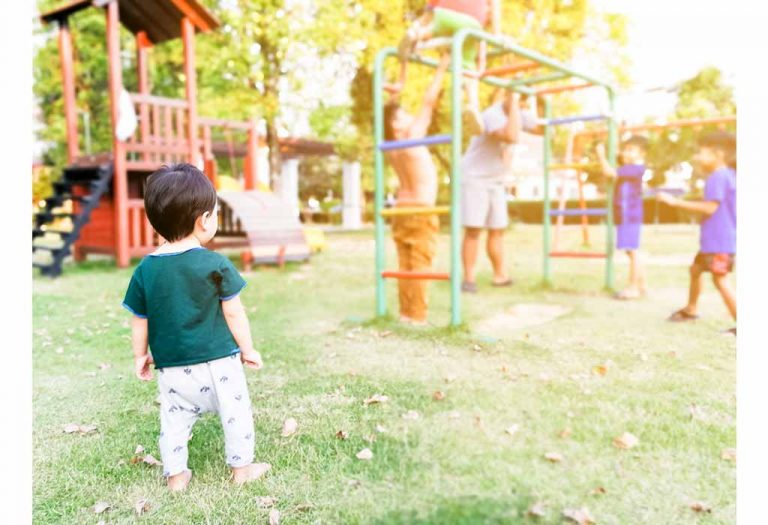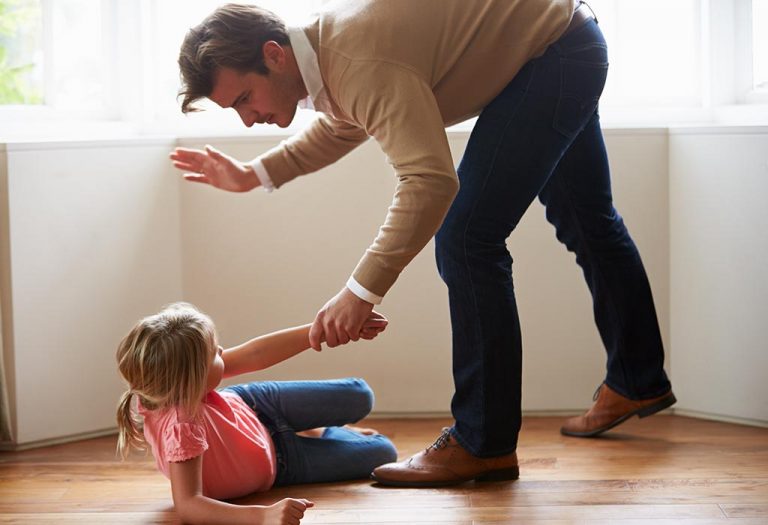Onlooker Play: What It Is and Why It Matters in Child Development
- What Is Onlooker Play?
- Some Examples of Onlooker Play
- What Age Does Onlooker Play Begin?
- What Are the Benefits of Onlooker Play?
- Ways to Encourage Your Child During Onlooker Play
- What Time Does Onlooker Play Come to an End?
- Infographic
- FAQs
Have you ever watched a group of children play and noticed one kid hanging back, just observing? You might think, “Why isn’t that child joining in?” Well, what you’re witnessing could be a key stage of development called onlooker play. Unlike other types of play, where kids are actively involved, onlooker play involves a child watching others without participating. This is more than just shyness or hesitancy—it’s a critical part of growing up!
The onlooker play meaning isn’t as simple as a child not wanting to engage. It can actually be an important step toward developing social, cognitive, and emotional skills. But what is onlooker play really, and why does it matter so much? Let’s dive deeper into its role in child development and why this type of observation is far from passive or unimportant.
What Is Onlooker Play?
Onlooker play is when a child watches others play without joining in. While it may seem like they are just standing on the sidelines, there’s a lot going on in their mind. The onlooker play definition revolves around observation, learning, and building social understanding.
During this stage, children absorb how others interact, use toys, and communicate, which helps them prepare for future play. This type of play often occurs in public settings like parks or playgrounds, where the child can observe many different behaviours and games. It’s a vital part of their social development, even if they aren’t physically participating.
Some Examples of Onlooker Play
Onlooker play happens when a child watches others play without directly joining in. Even though they aren’t participating, they are learning a lot just by observing. Below are a few common examples of onlooker play, where children observe and absorb social interactions, game rules, and communication skills.
- A child at the playground might stand near the swing set or slide and watch other children play. They may observe how kids take turns, how they react to falling or climbing, and even how they interact with their caregivers. While the observing child isn’t ready to swing or slide just yet, they are learning important lessons about patience, risk-taking, and social cues like waiting their turn. Watching how other kids use the equipment can also help them understand the mechanics of playground activities when they decide to participate.
- In a classroom setting, you might see a child standing to the side while a group of kids is building a tower with blocks. They carefully watch how the others cooperate, how the blocks are stacked, and what happens when the tower falls. This child is silently gathering information about teamwork, problem-solving, and communication. Even though they aren’t playing yet, they’re learning how to ask for a turn, share ideas, and build something together with others when they eventually decide to join in.
- At a local park, a child might watch older kids playing a soccer game. The observing child follows the ball with their eyes, watches how players run and kick, and notices the rules of the game. They might see how players celebrate goals or handle losing, which teaches them emotional responses in sports. Although they don’t participate, this observation helps them understand how the game works, how to communicate during play, and how teamwork is essential, all of which will prepare them for playing sports later.
- At home, a younger sibling might watch their older brothers or sisters play a board game like Monopoly or Candy Land. They sit nearby, observing the dice rolls, the moves on the board, and the occasional disputes over rules. The child learns about strategy, turn-taking, and following the rules just by watching. This helps them grasp the game’s flow and understand social interactions in a low-pressure setting. When the time comes to play, they will be more prepared and confident.
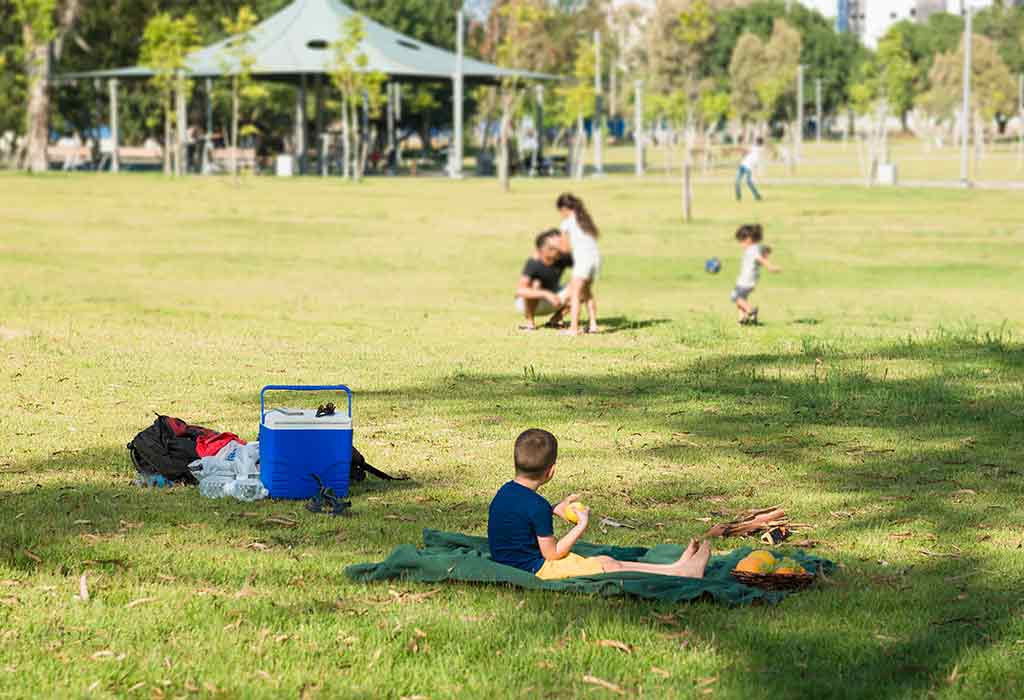
What Age Does Onlooker Play Begin?
Onlooker play typically begins around the ages of 2 to 3 years old. At this stage, children are becoming more aware of their surroundings and other kids but may not yet feel ready to join in. This phase is a natural part of early childhood development and can last until the child feels comfortable enough to engage in group play.
What Are the Benefits of Onlooker Play?
Onlooker play provides several benefits to young children as they observe and learn from others. Though they aren’t actively participating, they are developing important skills that will help them in future social interactions and play situations. Below are some of the key benefits that onlooker play offers.
1. Social Learning
Through onlooker play, children observe how others interact, share, and resolve conflicts. By watching from a distance, they learn about social norms and behaviours. This helps them understand how to communicate and cooperate with others in group settings, which prepares them for their own social experiences when they feel ready to engage.
2. Language Development
Children often pick up new words and phrases by listening to others during play. They hear how language is used in conversation, how kids give instructions, and how they express emotions. This helps them build their vocabulary and understand how to use language appropriately in different social situations, even before they start speaking up themselves.
3. Confidence Building
Onlooker play allows children to observe and gain confidence before diving into social activities. By watching others play, they get familiar with the rules and dynamics of the game or activity. Once they feel ready and confident in their understanding, they are more likely to join in and participate comfortably.
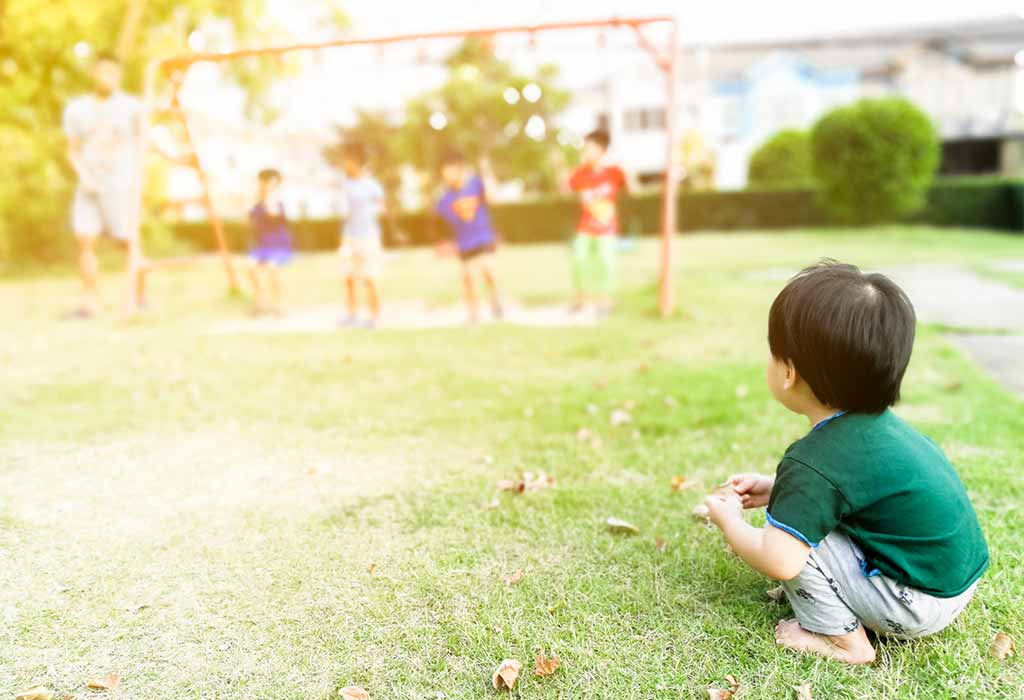
4. Emotional Understanding
By watching how others react to winning, losing, or sharing, children learn to understand emotions. They see how different situations trigger different emotional responses, which helps them build empathy and develop better emotional regulation. This prepares them to handle their own feelings when they eventually join in on play.
5. Problem-Solving Skills
As children observe others playing, they also watch how problems are solved. Whether it’s figuring out how to share toys or working through a disagreement, onlooker play helps children understand various approaches to problem-solving. This can be valuable for their own decision-making when they begin to participate actively.
6. Perspective Taking
Onlooker play gives children the chance to see things from another person’s point of view. They get to watch how others think, act, and react, which teaches them the ability to understand different perspectives. This helps develop their social skills and makes it easier for them to navigate group situations in the future.
7. Reducing Social Anxiety
For children who may feel shy or anxious in group settings, onlooker play provides a way to feel involved without the pressure of participation. It allows them to observe and get comfortable with the environment, making the transition into active participation smoother and less overwhelming when they are ready.
Ways to Encourage Your Child During Onlooker Play
When your child is in the onlooker play stage, it’s important to support them in a way that nurtures their confidence and curiosity. Encouraging them without pushing too hard allows them to develop at their own pace. Below are some ways you can help during this phase.
1. Be Patient and Supportive
Give your child time to observe and process what they are seeing. Pushing them to join in too quickly can make them feel overwhelmed. Instead, show understanding and let them decide when they’re ready to participate. Your patience will help them feel safe and more comfortable in group settings over time.
2. Engage Them in Conversations
Ask your child open-ended questions about what they’re observing, like “What are the other kids doing?” or “Does that look fun to you?” This encourages them to think about the activity and keeps them engaged without the pressure to join in. Conversations help them stay connected to the play even as an observer.
3. Be a Role Model
Sometimes, showing your child how to join in can make a big difference. If you’re at the playground, participate in the activities yourself or start a simple game with the other kids. By modelling how to join the group, you’re demonstrating that it’s fun and okay to be part of the play when they feel ready.
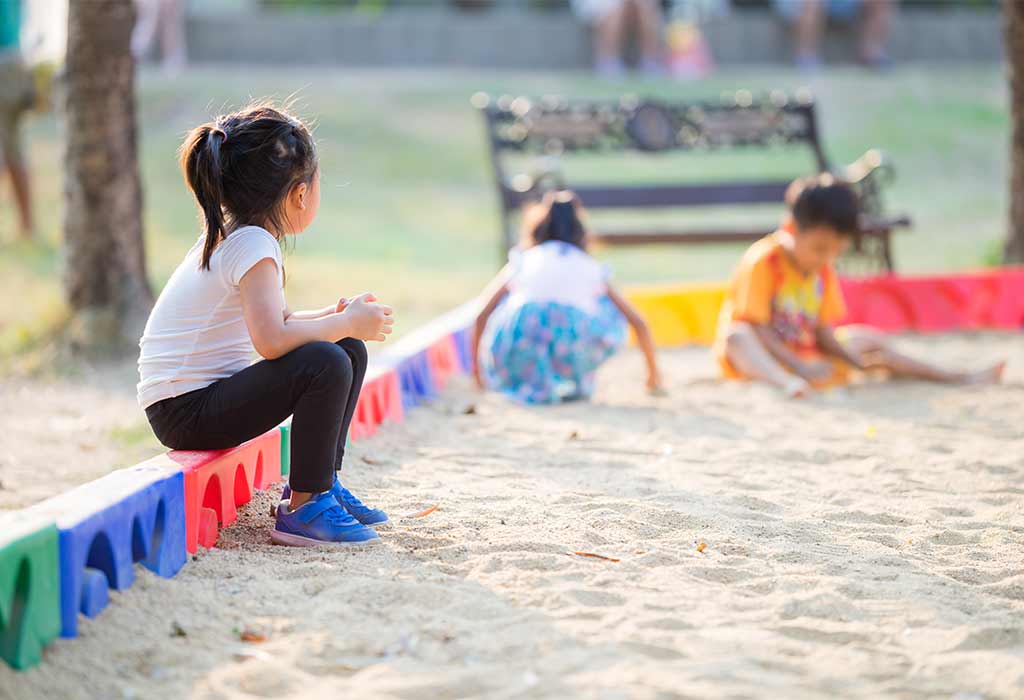
4. Create Play Opportunities at Home
Set up playdates or create group activities at home where your child feels more comfortable. In a familiar setting, they may be more willing to join in and interact with others. Practising social skills at home can boost their confidence and make it easier for them to engage in play outside the home.
5. Offer Gentle Encouragement
If you notice your child showing signs of wanting to join in, give them a gentle nudge with words of encouragement. Say things like, “It looks like fun; maybe you can try it when you’re ready.” This subtle support reassures them without making them feel pressured or anxious about joining the group.
6. Praise Their Observations
Acknowledge your child’s observation skills. Let them know that watching others play is a valuable way to learn. Positive reinforcement helps them feel good about their role as an observer and builds their confidence for when they decide to participate. This boosts their sense of self and shows that there’s no rush to join in.
What Time Does Onlooker Play Come to an End?
Onlooker play typically starts to end when a child starts becoming more confident and comfortable with social interactions. This typically happens around ages 3 to 4, though every child is different. As they gain social skills and feel ready to participate, onlooker play naturally transitions into more active forms of play, like parallel or cooperative play.
Infographic
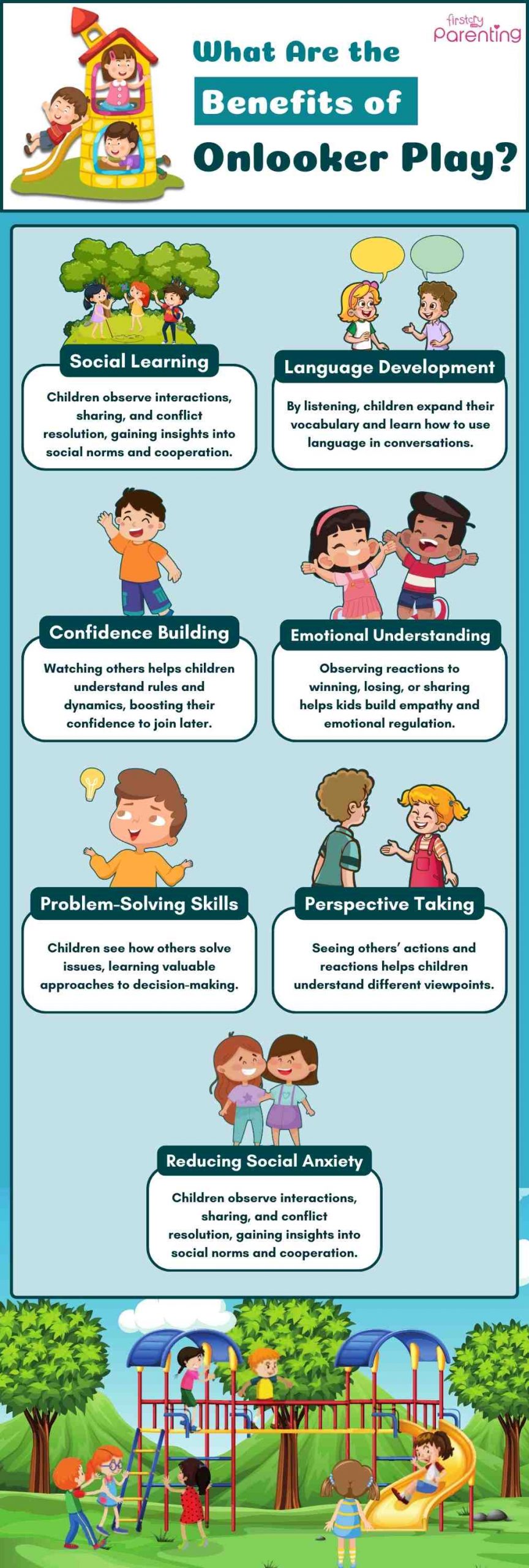
FAQs
1. Is onlooker play normal for toddlers?
Yes, onlooker play is a normal and important part of a toddler’s development. It allows them to observe and learn social behaviours before feeling comfortable enough to join in.
2. How long does the onlooker play stage last?
The onlooker play stage usually lasts from ages 2 to 3 and can continue until the child is ready for more interactive play, around age 4. However, every child develops at their own pace.
3. Does onlooker play mean my child is shy?
Not necessarily. While some shy children may engage in onlooker play more often, it’s typical behaviour that helps all children learn about social dynamics and play interactions.
4. Can onlooker play help with language development?
Yes, during onlooker play in early childhood, children can pick up new vocabulary and learn how language is used in different social situations by listening to others.
5. Should I be concerned if my child only watches and never plays?
It’s generally not a cause for concern. Onlooker play is a stepping stone toward active participation. If your child shows no interest in playing with others for an extended period, though, you can gently encourage them or seek advice from a paediatrician.
Onlooker play is a valuable stage in early childhood development, helping children learn by watching others. Though it might seem like they are just standing back, they are actually gaining important social and cognitive skills. This phase allows children to observe, build confidence, and understand how play works before they join in. It’s important for parents to be patient and offer gentle encouragement during this time. Every child moves through this stage at their own pace, and that’s completely normal. Eventually, they will feel ready to participate more actively. Onlooker play is just one of the many steps toward healthy social development.
Also Read:
Parallel Play – How Does It Benefit Your Child
Types of Play For Child Development
Importance of Play in Your Child’s Development
Was This Article Helpful?
Parenting is a huge responsibility, for you as a caregiver, but also for us as a parenting content platform. We understand that and take our responsibility of creating credible content seriously. FirstCry Parenting articles are written and published only after extensive research using factually sound references to deliver quality content that is accurate, validated by experts, and completely reliable. To understand how we go about creating content that is credible, read our editorial policy here.






